 W
WLouis des Balbes de Berton de Crillon, 1st Duke of Mahón, 2nd Duke of Crillon was a Franco-Spanish military officer who reached the rank of Captain general of the Army. He became a soldier at the age of 16 and served with distinction in the French army before transferring to the army of Spain, which was allied with France for much of the 18th century. A member of a distinguished military family, he was widely admired for his personal courage, courtesy and chivalry. By the end of his life he had risen to the highest military rank in Spain and it was said that he had served in 68 engagements.
 W
WPierre Raphaël Paillot de Beauregard led a French division at the Battle of Wattignies. A nobleman, he joined the French Royal Army as a cadet in 1755 and fought in the Seven Years' War. He became a lieutenant colonel in 1779, but two years later got into a dispute with a superior officer and was placed on inactive service. The French Revolution and the War of the First Coalition saved his career; he was promoted general of brigade in 1792. He led a 2,000-man column at Arlon in 1793 but irritated his army commander. After his 5,800-strong division performed poorly at Wattignies he was put in prison for 10 months. He was briefly employed again during the War in the Vendée in 1795 before retiring from military service in 1796.
 W
WPierre-Joseph Bourcet was a French tactician, general, chief of staff, mapmaker and military educator. He was the son of Daniel-André Bourcet and of Marie-Magdeleine Legier.
 W
WLouis Charles Auguste Le Tonnelier, Baron de Breteuil, Baron de Preuilly was a French aristocrat, diplomat and statesman. He was the last Prime Minister of the Bourbon Monarchy, appointed by King Louis XVI only one hundred hours before the storming of the Bastille.
 W
WCharles-François de Broglie, marquis de Ruffec, was a French soldier and diplomat from the House of Broglie.
 W
WVictor François de Broglie, 2nd duc de Broglie was a French aristocrat and soldier and a marshal of France. He served with his father, François-Marie, 1st duc de Broglie, at Parma and Guastalla, and in 1734 obtained a colonelcy.
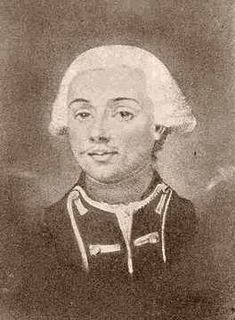 W
WGaspard Jean-Baptiste Brunet commanded the French Army of Italy during the French Revolutionary Wars and was executed during the Reign of Terror. Despite this fate his son Jean Baptiste Brunet also became a French general. From the minor nobility, he entered the French Royal Army as a gunner in 1755, transferred to an infantry unit and fought in the Seven Years' War. He received the Order of Saint-Louis and was promoted to lieutenant colonel in 1779.
 W
WCharles Joseph Patissier, Marquis de Bussy-Castelnau or Charles Joseph Patissier de Bussy was the Governor General of the French colony of Pondicherry from 1783 to 1785. He served with distinction under Joseph François Dupleix in the East Indies, receiving the Order of Saint Louis. He contributed to the recovery from Britain of Pondicherry in 1748, and was named in 1782 to lead all French military forces beyond the Cape of Good Hope. He coordinated his operations with Pierre André de Suffren and fought against the British during the Indian campaigns of the American War of Independence.
 W
WFrançois Jean de Beauvoir, Marquis de Chastellux, was a military officer who served during the War of American Independence as a major general in the French expeditionary forces led by general Comte de Rochambeau. Being on general Rochambeau's staff for the duration of the war, Chastellux acted as the principal liaison officer between the French commander in chief and George Washington. However the Chevalier de Chastellux was also widely recognized, at the time of his campaigns in America, as a highly talented man of letters and a member of the Académie française
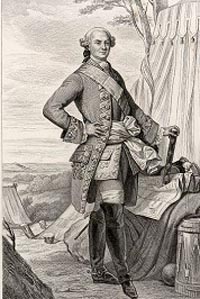 W
WJacques Philippe de Choiseul was a French Marshal of France, general and nobleman. He became count and then in 1786 duke of Choiseul-Stainville and baron of Dommanges.
 W
WCharles Pierre Claret, comte de Fleurieu was a French Navy officer, explorer, hydrographer and politician. He served as Minister of the Navy under Louis XVI, and was a member of the Institut de France. He was brother to botanist Marc Antoine Louis Claret de La Tourrette.
 W
WLouis Joseph de Bourbon was Prince of Condé from 1740 to his death. A member of the House of Bourbon, he held the prestigious rank of Prince du Sang.
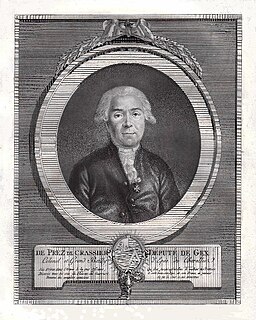 W
WJean Étienne Philibert de Prez de Crassier or Étienne Desprez-Crassier was a French political and military leader in the early years of the French Revolutionary Wars. Despite being from the minor nobility, he entered the French Royal Army as a cadet at the age of 12 because of his family's poverty. He fought in the War of the Austrian Succession and the Seven Years' War, becoming a colonel in 1785 and retiring two years later. Voltaire lent him the money needed to recover the Deprez family property. He was elected to the Estates General as a nobleman in 1789. After being promoted to lieutenant general he led a division at Valmy in 1792. He became commander of the Army of the Rhine and Army of the Western Pyrenees. Imprisoned during the Reign of Terror, he was released and restored to his former rank but retired in 1796.
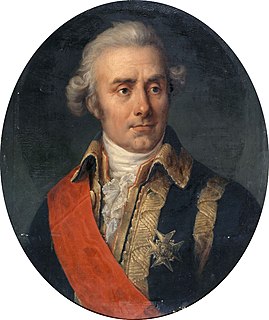 W
WLouis Charles du Chaffault de Besné was a French Navy officer. He notably took part in the Second Battle of Cape Finisterre in 1747, and was one of the commanders at the Battle of Ushant on 27 July 1778.
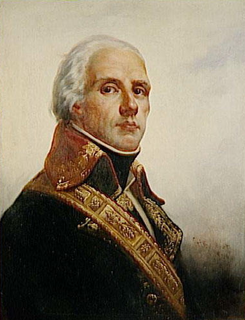 W
WJacques François Coquille named Dugommier was a French general.
 W
WJean Baptiste Charles Henri Hector, comte d'Estaing was a French general and admiral. He began his service as a soldier in the War of the Austrian Succession, briefly spending time as a prisoner of war of the British during the Seven Years' War. Naval exploits during the latter war prompted him to change branches of service, and he transferred to the French Navy.
 W
WThomas de Mahy, marquis de Favras was a French aristocrat and supporter of the House of Bourbon during the French Revolution. Often seen as a martyr of the Royalist cause, Favras was executed for his part in "planning against the people of France" under the Comte de Provence. He is known for his last words, "I see that you have made three spelling mistakes," upon reading his death sentence warrant.
 W
WJean Henri Becays Ferrand or Jean Marie Begais Ferrand de la Caussade became a French general officer early in the French Revolutionary Wars and led troops during two early actions. From a noble family, he was enrolled in the French Royal Army as an officer in the Normandie Infantry Regiment. At the age of ten, he fought at Lauffeld and Bergen op Zoom in the War of the Austrian Succession. In 1760 during the Seven Years' War, he was badly wounded at Kloster Kampen. For distinguished service, he was promoted to captain.
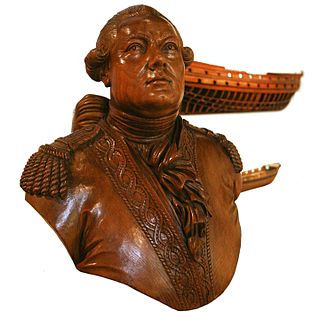 W
WAntoine Groignard, was a French naval constructor who developed standard designs for French war ships, and built and improved the dry docks at the French naval bases in Toulon and Brest.
 W
WAdrien-Louis de Bonnières, comte later duc de Guînes was an aristocrat of the Ancien Régime, who served as a French Army general and diplomat; he was also a favourite of Queen Marie-Antoinette.
 W
WCharles Jean d'Hector, comte d'Hector was a French aristocrat and naval officer. Losing his father at a young age, he soon entered the French Navy, starting his service during the Seven Years' War, notably at the battle of Quiberon Bay. Following that battle he and the chevalier de Ternay saved part of the French fleet which had taken refuge in the Vilaine estuary. He was promoted to capitaine de vaisseau then squadron commander at the start of the American Revolutionary War. Put in command of Brest and its naval force, he assisted the Naval Minister maréchal de Castries in his plans to reform the fleet. He was visited at Brest by the future Tsar Nicholas I and his family and at Cherbourg on an inspection by Louis XVI of France.
 W
WFrançois-Étienne-Christophe Kellermann or de Kellermann, 1st Duke of Valmy was a French military commander, later the Général d'Armée, a Marshal of the Empire and a freemason. Marshal Kellermann served in varying roles throughout the entirety of two epochal conflicts, the French Revolutionary Wars and the Napoleonic Wars. Kellermann is one of the names inscribed under the Arc de Triomphe, on Column 3.
 W
WAugustin Mottin de la Balme was a French cavalry officer who served in Europe during the Seven Years' War and in the United States during the American Revolution. His attempt to capture Fort Detroit in 1780 ended in defeat when he was ambushed by forces under Chief Little Turtle.
 W
WAugustin de Lespinasse commanded French artillery during the French Revolutionary Wars. After fighting in the Seven Years' War he switched to the artillery branch. He advanced in rank to major by 1788 and was attached to the Army of the Rhine in 1791. After transferring to the Army of the Western Pyrenees as chief of artillery, he coolly directed the successful defence of the Sans Culottes Camp in February 1794. He was soon promoted to general of division but the Minister of War blocked his continued employment.
 W
WLouis Jean de la Couldre, Comte de La Bretonnière, 6/8 July 1741, to 25 November 1809, was a French naval officer and engineer, who designed Cherbourg Harbour.
 W
WLouis François Joseph de Bourbon or Louis François II, Prince of Conti, was the last Prince of Conti, scion of a cadet branch of the House of Bourbon, whose senior branches ruled France until 1848. His title was honorary and did not carry any territorial jurisdiction.
 W
WDaniel Charles, Count O'Connell was the uncle of Daniel O'Connell "the Liberator." He was from a noble family of Derrynane House, County Kerry, Ireland, but because of the Penal Laws (Ireland) of the time, which forbade a Catholic to have any education or profession, he, like many other ambitious young Irishmen, went to the Continent for an education, and remained abroad. He entered the service of the king of France in the Royal Swedish Regiment in 1761, and in 1769 was transferred to Lord Clare's Regiment of the Irish Brigade (French) and served in Europe and Mauritius until 1778. Then he was appointed Lieutenant-Colonel and transferred back to the Royal Swedish Regiment, with which he saw action at the siege of Port Mahon and at the Great Siege of Gibraltar. "At Gibraltar he was on board one of the famous floating batteries and was severely wounded." He was later appointed Colonel Commander of the Régiment de Salm-Salm, and was created a Chevalier of the Order of Saint Louis. He also was appointed to a military committee charged with revising French infantry tactics.
 W
WLouis François Armand de Vignerot du Plessis, duc de Richelieu, was a French soldier, diplomat and statesman. He joined the army and participated in three major wars. He eventually rose to the rank of Marshal of France.
 W
WGeorges-René Le Peley de Pléville was the governor of the port of Marseilles, a French admiral, minister for the navy and the colonies from 15 July 1797 to 27 April 1798, a senator, a knight of the Order of St Louis and the Order of Cincinnatus, and one of the first Grand officiers of the Légion d'honneur.
 W
WLouis François Perrin, comte de Précy, was a French nobleman and soldier who lead royalist forces during the Siege of Lyon.
 W
WPaul François de Quelen de La Vauguyon or Paul François de Quélen de Stuer de Caussade, duc de La Vauguyon was a French nobleman. He was governor of Cognac, after having been involved in the last campaigns of the Seven Years' War. He wrote a Portrait de feu monseigneur le Dauphin and was menin to the future Louis XVI, one of the Dauphin's sons. A peer of France, brigadier, maréchal de camp, knight of the ordre du Saint-Esprit, he was chosen to be minister plenipotentiary to the Estates General of the Dutch Republic. He later became French ambassador to Spain, knight of the Golden Fleece, temporary minister of foreign affairs in 1789, then minister of the conseil d'État of Louis XVIII in Verona. He was the main intermediary among Louis's agents in France, but became the victim of intrigues. From the Restoration onwards he was lieutenant général and sat in the peerage of France, where he was noted for his moderation. He and his wife had four children, but the Quelen line died out with his children.
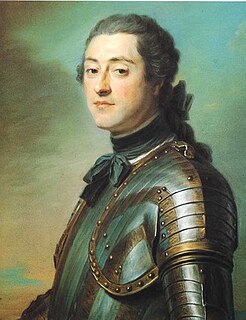 W
WMarc René, Marquis de Voyer de Paulmy d'Argenson (1721–1782), known as the Marquis de Voyer was a French army officer.
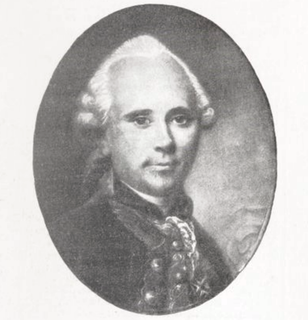 W
WFrançois Hector d’Albert, comte de Rioms or Rions was a French Navy officer. He served in the War of American Independence, earning a membership in the Society of Cincinnati.
 W
WPierre-François, Marquis de Rougé (1702–1761) was a French nobleman and general of the French armies, member of the House of Rougé. He was most famous for having signed the war treaty "Convention de Brandenburg" in the name of King Louis XV.
 W
WDonatien Alphonse François, Marquis de Sade, was a French nobleman, revolutionary politician, philosopher and writer famous for his libertine sexuality. His works include novels, short stories, plays, dialogues, and political tracts. In his lifetime some of these were published under his own name while others, which de Sade denied having written, appeared anonymously. De Sade is best known for his erotic works, which combined philosophical discourse with pornography, depicting sexual fantasies with an emphasis on violence, suffering, anal sex, crime, and blasphemy against Christianity. He was a proponent of absolute freedom, unrestrained by morality, religion, or law. The words sadism and sadist are derived in reference to the works of fiction he wrote which portrayed numerous acts of sexual cruelty. While de Sade mentally explored a wide range of sexual deviations, his known behavior includes "only the beating of a housemaid and an orgy with several prostitutes—behavior significantly departing from the clinical definition of sadism". De Sade was a proponent of free public brothels paid for by the state: In order both to prevent crimes in society that are motivated by lust and to reduce the desire to oppress others using one’s own power, de Sade recommended public brothels where people can satisfy their wishes to command and be obeyed.
 W
WJean-Mathieu-Philibert Sérurier, 1st Count Sérurier led a division in the War of the First Coalition and became a Marshal of the Empire under Emperor Napoleon. He was born into the minor nobility and in 1755 joined the Laon militia which was soon sent to fight in the Seven Years' War. After transferring into the regular army as an ensign, he was wounded at Warburg in 1760. He fought in the Spanish-Portuguese War in 1762. He married in 1779 after a promotion to captain. A newly minted major in 1789, the French Revolution sped up promotion so that he was colonel of the regiment in 1792. After leading Army of Italy troops in a number of actions, he became a general of brigade in 1793 and a general of division the following year.
 W
WHenri Christian Michel de Stengel joined the French royal army, rapidly rose to general officer rank during the French Revolutionary Wars, and was mortally wounded in Italian campaign while serving in General Napoleon Bonaparte's army.
 W
WCharles-Henri-Louis d'Arsac, chevalier de Ternay was a French naval officer. Most active in the Seven Years' War and the War of American Independence, Ternay was the naval commander of a 1762 expedition that successfully captured St. John's Newfoundland. He was appointed commander of the Marine Royale, French naval forces, as part of the project code named Expédition Particulière that brought French troops to American soil in 1780. He died at Hunter House on Washington Street, which was headquarters for the French fleet in Newport, Rhode Island.
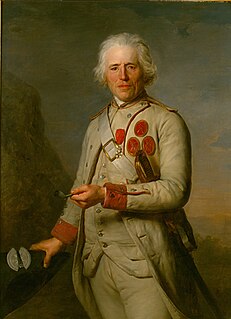 W
WJean Thurel, or Jean Theurel, was a fusilier of the French Army and a centenarian with an extraordinarily long career that spanned over 75 years of service in the Touraine Regiment. Born in the reign of Louis XIV and dying during that of Napoleon I, Thurel lived in three different centuries.
 W
WJean Vauquelin was a French naval officer.
 W
WNoël Jourda de Vaux, comte de Vaux, seigneur d'Artiac was a French nobleman and General. He oversaw the conquest of the Corsican Republic in 1769. He was given command of land forces in the planned Franco-Spanish Invasion of Britain in 1779, but this was abandoned. He became a Marshal of France in 1783. He was the son of Jean Baptiste Jourda de Vaux, seigneur de Retournac and Marie Anne de Saint-Germain.